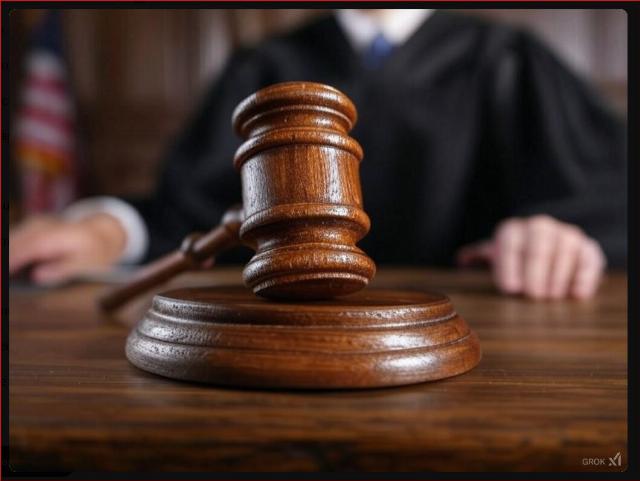
Today, the most dangerous weapon in America’s federal district courts isn’t a statute. It’s the injunction—and the refusal of judges to require the party seeking that relief to post a bond. And the injunction, once a rarely granted tool of last resort, has become a chaos agent—deployed incessantly to paralyze the current administration and grind lawful executive action to a halt.
That’s precisely what we’ve seen—again and again—as activist judges block significant Trump administration policies without requiring plaintiffs to post the injunction bond that Rule 65(c) of the Federal Rules of Civil Procedure flatly mandates.
Here’s the text—brief, unambiguous, and routinely ignored:
The court may issue a preliminary injunction or a temporary restraining order only if [emphasis added] the movant gives security in an amount that the court considers proper….
Not “may.” Not “should.” Only if.
Yet across the federal bench, this rule is all too often honored in the breach—waived, ignored, or omitted when the political stakes demand expedience over equity.
Take U.S. District Judge James Bredar, who recently ordered the federal government to rehire thousands of employees terminated under a presidential reorganization directive. The order, initially nationwide, was later narrowed to the 19 states and the District of Columbia that filed suit. But the scale of the relief remained staggering: backpay, benefits, re-entry processing, and administrative disruption across dozens of federal agencies.
Judge Bredar did require the states to post a bond—but only $100 apiece, totaling a mere $2,000 in security for a sweeping injunction that could cost taxpayers millions. In form, a bond was imposed. In substance, it was little more than a token gesture. The result: a massive federal directive hogtied with virtually no financial accountability.
And Judge Bredar wasn’t alone. In a separate case, U.S. District Judge James Boasberg issued a temporary restraining order halting deportations under the Alien Enemies Act after the Trump administration invoked it to remove foreign nationals associated with the Venezuelan gang Tren de Aragua. But according to a Wall Street Journal op-ed, Boasberg’s ruling didn’t even mention Rule 65(c)—let alone justify waiving its bond requirement.
Whether that’s deliberate judicial activism or casual carelessness is a distinction without a difference. The result is the same: federal action is paralyzed, costs are shifted to the public, and plaintiffs are shielded from consequences.
Rule 65(c) is a substantive procedural guardrail—recognized and enforced by appellate courts across jurisdictions. This rule exists to balance the equities when injunctive relief is granted, ensuring that should the court improvidently grant an injunction—the restrained party can recover damages for the harm wrongly inflicted.
In Hoechst Diafoil Co. v. Nan Ya Plastics Corp., 174 F.3d 411 (4th Cir. 1999), the Fourth Circuit wrote:
This rule is mandatory and unambiguous. Although the district court has discretion to set the bond amount ‘in such sum as the court deems proper,’ it is not free to disregard the bond requirement altogether. In view of the clear language of Rule 65(c), failure to require a bond upon issuing injunctive relief is reversible error. [Internal citations omitted.]
The Third Circuit, in Instant Air Freight Co. v. C.F. Air Freight, Inc., 882 F.2d 797 (3d Cir. 1989), was equally blunt:
The bond requirement serves to protect the restrained party from losses… Its waiver is appropriate only in the most extraordinary circumstances.
And yet, courts continue to enjoin the executive branch—sometimes forcing hiring, sometimes halting deportations, always bypassing or truncating the bond. This judicial free-for-all has created a patchwork of enforcement, wildly divergent from district to district, judge to judge. It is now well past the point where only the Supreme Court can reassert uniformity consistent with the demands of the Rule.
The justices cannot remain on the sidelines while lower courts treat Rule 65(c) as optional—depending on whose ox is being gored. If fundamental procedural safeguards are no longer applied consistently across the judiciary to the detriment of the political branches, then the Constitution is imperiled—not just policy.
In just the first ten weeks of President Trump’s second term, federal courts issued 17 nationwide injunctions—a pace that far exceeds anything seen under presidents Bush, Obama, or Biden. By contrast, the first Trump administration faced 64 nationwide injunctions—more than double the total issued against Bush, Obama, and Biden combined.
The goal is unmistakable: to delay, drain, and disable—using the courts as a procedural chokehold on lawful executive action.
President Trump anticipated the ambush. In March, the White House ordered DOJ attorneys to demand injunction bonds in all applicable cases—a defensive measure against lawsuits that tie down entire government departments.
Still, many judges ignore it. Others, like Judge Bredar, treat tangible financial accountability as incompatible with the aims of progressive litigation.
Congress has noticed. Senator Chuck Grassley has introduced legislation to limit nationwide injunctions by restricting court orders to the actual parties before the court. In the House, Republicans are advancing the No Rogue Rulings Act this session in an effort to rein in such rulings. But with razor-thin margins in both chambers, the odds of final passage for any such legislation remain uncertain.
That leaves another constitutional remedy: limiting the jurisdiction of the district courts under Article III. If judges continue acting as one-person Supreme Courts, Congress has every authority—and growing necessity—to narrow their reach.
Yet Rule 65(c) is no mere procedural nicety. It is a condition precedent to equitable relief, grounded in the principles of due process and judicial restraint. When courts waive or ignore it, the result is more than an abuse of discretion—it is a circumvention of a rule rooted in a 1914 statutory command, later codified through the Rules Enabling Act and approved by Congress. That is a direct intrusion into the legislative domain.
But the overreach doesn’t stop there. In issuing sweeping nationwide injunctions that compel federal rehiring, halt deportations, or command public expenditures—all without requiring a just and proportionate bond—the judiciary isn’t merely encroaching on Congress. It is usurping the executive’s constitutional role.
Simply put, the courts are initiating a full-blown constitutional crisis—intruding simultaneously on the prerogatives of both elected branches of government, each directly accountable to the citizenry of the Republic.
We are witnessing the judicial assumption of power that was never theirs to wield. It is, in Hamilton’s words from Federalist No. 78, the “least dangerous” branch only so long as it possesses:
[N]o influence over either the sword or the purse; no direction either of the strength or of the wealth of the society; and can take no active resolution whatever. It may truly be said to have neither FORCE nor WILL, but merely judgment; and must ultimately depend upon the aid of the executive arm even for the efficacy of its judgments.
And yet, here we are—with judges wielding the sword, spending the purse, and evading the bond. That is how far we’ve drifted from the Founders’ vision. That constitutional crisis no longer lurks in the shadows—it is growing in plain sight, and at such an alarming rate that the Supreme Court can no longer look the other way.
It’s time to restore the bond—and take a small but necessary step toward restoring constitutional balance.
Charlton Allen is an attorney, former chief executive officer, and chief judicial officer of the North Carolina Industrial Commission. He is the founder of the Madison Center for Law & Liberty, Inc., editor of The American Salient, and the host of the Modern Federalist podcast. X: @CharltonAllenNC
<img alt="Judge's gavel" captext="x grok” src=”https://conservativenewsbriefing.com/wp-content/uploads/2025/04/the-least-dangerous-branch-no-more.jpg”>
Image from Grok.






